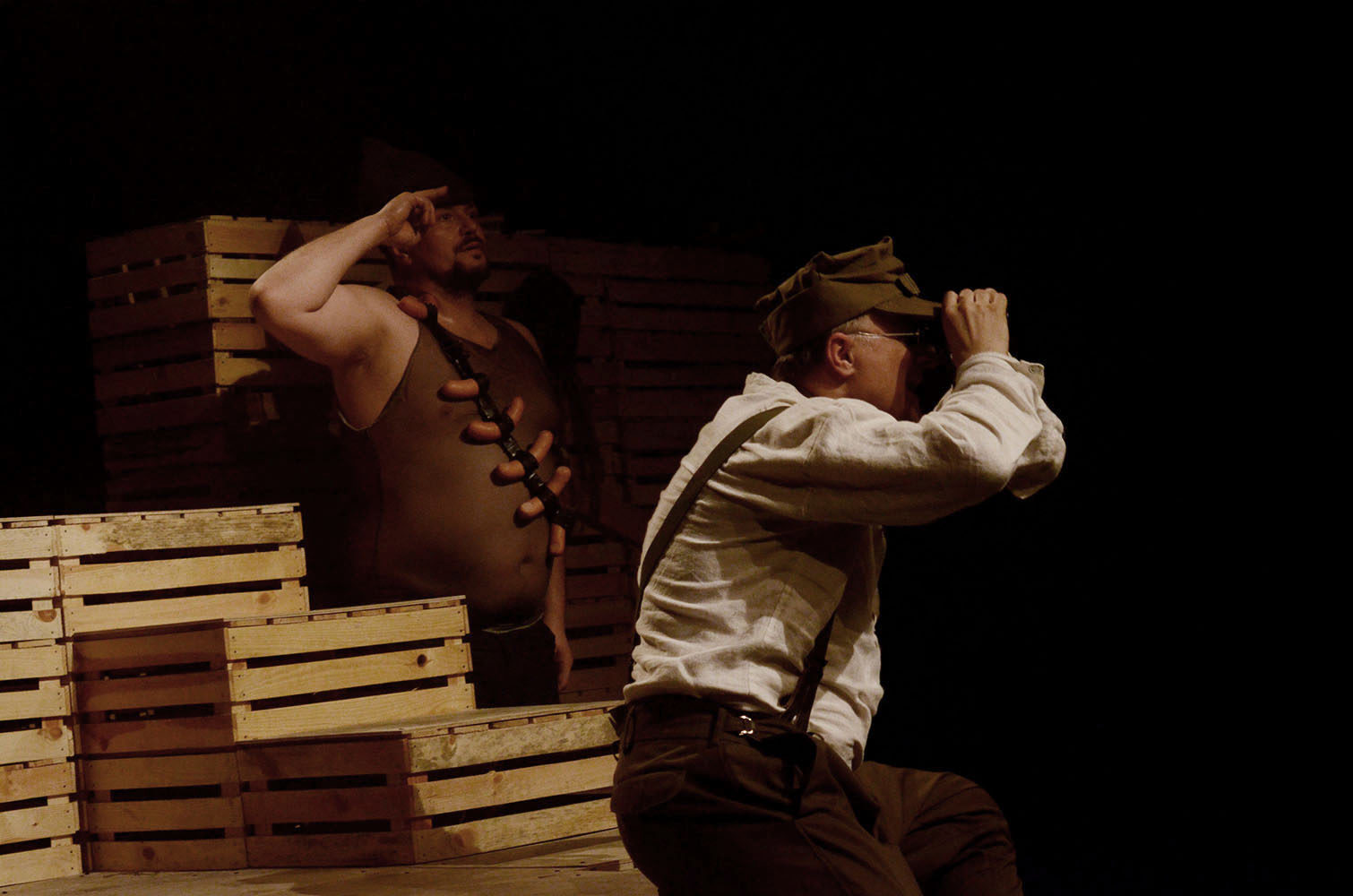W ramach projektu „Wizyta” Teatr Usta Usta Republika przedstawił w Centrum Kultury eSTeDe przedpremierowo swój najnowszy spektakl „Batalion”. Usta Usta to ekipa, której fanom teatru niezależnego czy też offowego nie trzeba przedstawiać. Jeden z obecnych filarów środowiska teatralnego Poznania, zespół, który swoim podejściem do organizacji przestrzeni spektaklu, zdecydowanie wyróżnia się wśród podobnych ekip w Polsce, swój najnowszy spektakl pokazał na blisko miesiąc przed poznańską premierą właśnie w Gnieźnie.

Ten realizm krzywego zwierciadła, każe traktować sad i jabłka w kategoriach symbolu.
Widownia nawet ta, która wcześniej nie znała Teatru Usta Usta bardzo szybko weszła w stworzony przez Usta świat. Świat z pogranicza absurdu i teatru realistycznego, był w pełni stworzonym na potrzeby teatru, nie udawał ani nie odzwierciedlał a jednocześnie był poprzez symbolikę metafory i punkty odniesienia mocno rzeczywisty. Ten realizm krzywego zwierciadła, każe traktować sad i jabłka w kategoriach symbolu. Symbol ten w pewien jednoznaczny sposób nawiązuje do niedawnego potraktowania polskich owoców w kategorii „jabłka a sprawa Polska”. Nie mniej, tak naprawdę spektakl traktuje wojny i wojenki bardzo uniwersalnie.

Wydaje się, też, że spektakl raczej każe postawić sobie widzowi pytania, nie tylko o sens wojen, czy o ich prawdziwą genezę daleką raczej od wszelkich przypisywanych wojną wartości. Nie otrzymujemy jednak jasnego obrazu, trudno powiedzieć też że jakakolwiek z postaw wobec wojny czy „sprawy polskiej” niezależnie czy tej jabłkowej czy innej, została wyśmiana. Mamy oczywiście odniesienia do sowietów, Rosji putinowskiej, ale też polskich skrajnych postaw. Widz raczej otrzymuje jako materiał do gorzkiego śmiechu same mechanizmy i niecne pobudki, kierujące często tymi, którzy dowodzą czy podżegają na wojnach i wojenkach.

Absurdalność osiągnięta przez nadanie wymiaru ogromnej rangi wojnie o jabłka, wojnie, której scenerią są skrzynki po jabłkach
odrobina purnonsensowa rewia mody wojennej, podział widowni na drużyny – pozwala Teatrowi Usta Usta obudzić nie tylko refleksję widza ale też pozwala widzowi na nabranie dystansu, do spraw najwyższej wagi, które czasem są tylko nadmuchanym balonem. Pojawia się też wątek pokazujący prawidła epoki mediów. „Nie ma trupów, nie ma newsa”. Świetny rzucany przez „matkę” Miłosz nie tylko kontrastuje zresztą tekstu i sytuacjami scenicznymi, jest pewnym wrzutem z świata, który każdy widz zna, ze świata książkowo-apelowego patriotyzmu. Oprócz wielopłaszczyznowości, może nawet zbytniego spiętrzenia aluzji i odniesień, bardzo dobrze poprowadzony plastycznie spektakl, głównie poprzez prace świateł i kostiumy.

Dobrze zagrane przez aktorów w bardzo nieakademicki sposób przedstawienie. Świetna interakcja z widzem. Jeden z tych spektakli, w których teatr już po 5 minutach narzuca sobie zawrotne tempo, i w większości utrzymuje je do końca. Być może przydały by się bardziej wyraziste momenty na zwolnionych obrotach, które podbiły by dynamikę zwłaszcza końcówki spektaklu. Nie mniej pełna sala w eSTeDe, świetne przyjęcie pozwalają napisać, że był to piękny i mocny akcent na koniec roku w Centrum Kultury eSTeDe.
As part of the project Wizyta, Theatre Usta Usta Republika appeared at the Centre for Culture eSTeDe with a preview of their latest play entitled Batalion. Usta Usta is a crew which does not need to be introduced to fans of independent or fringe theatre. The group, currently one of the pillars of the Poznań dramatic milieu, an ensemble whose approach to the organisation of the space of performance distinguishes it among similar theatres in Poland, came to Gniezno to show their latest play a month before its Poznań premiere.
The viewers, even those who had not previously known Theatre Usta Usta, very quickly sank into the world they created. A world on the boundary of the absurd and realism, created thoroughly for theatrical needs; it did not pretend nor reflect, at the same time being very realistic through the symbolism of metaphor and points of reference. This realism of distorted mirror dictated that the orchard and apples should be treated as a symbol, which quite unequivocally drew on the recent treatment of Polish fruit in terms of “apples and the Polish affair d’etat”. Still, the performance treats bigger and smaller wars in a very universal fashion.
It also seems that the performance induces the audience to ask questions, not only about the point of wars or their true causes, which have little to do with any values that the war is attributed. However, we do not obtain a clear picture; it is also difficult to say whether any of the attitudes towards war or the “Polish case”, apple-related or any other, are ridiculed. Naturally, there are references to the Soviets and Putin’s Russia but also to extreme Polish attitudes. The viewer is rather given the material for some bitter laughter: the mechanisms and the reprehensible reasons which often motivate those who command or incite wars of all kinds.
The absurdity achieved by attaching such a tremendous significance to the war for apples, which takes place in the scenery of apple crates, the somewhat pure-nonsensical parade of martial fashion, the division of the audience into teams, enables Theatre Usta Usta to invite reflection as well as enables the viewer to assume a distanced approach to the matters of the highest importance, which often prove to be no more than an over-inflated balloon. There is also a theme exposing the rules of the era of the media. “No dead, no news”. The brilliant lines from Miłosz quoted by the “mother” not only offer a contrast to the rest of the text and stage situations; it is also a quote from the world that every viewer knows, the world of patriotism known from books, assemblies and rallies. Apart from the multi-layered structure, even excess of allusions and references, the performance works very well visually, mainly thanks to the lighting and the costumes.
A performance well-played by the actors, in a very non-academic fashion. Splendid interaction with the audience. One of those performances in which the theatre achieves maximum revolutions after mere five minutes, and by and large maintains the pace until the end. Perhaps there could be more vivid moments delivered at a slower speed, which would boost the dynamism, especially towards the end of the performance. Nonetheless, the full house in eSTeDe and the wonderful reception of the audience warrant the conclusion that it was a beautiful and powerful note ending the year at the Centre for Culture eSTeDe.
